新一教案NCE23-26
NCE1-L1-Shirley新概念第一册教案
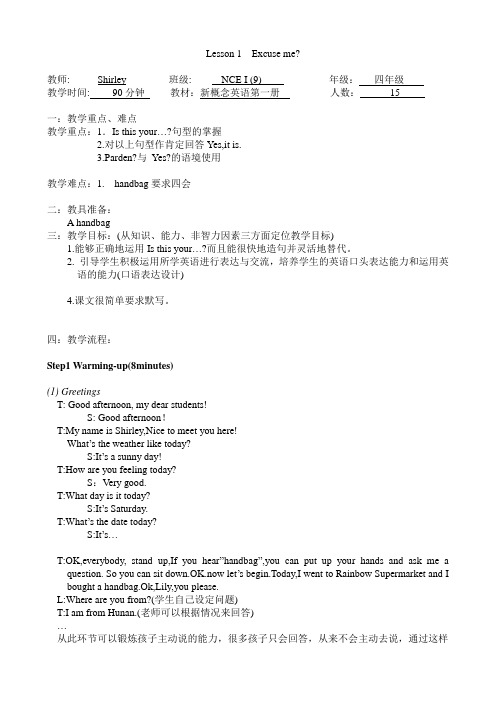
Lesson 1 Excuse me?教师: _____Shirley____ 班级: ____NCE I (9)___ _ 年级:四年级教学时间: 90分钟教材:新概念英语第一册人数:______15_____一:教学重点、难点教学重点:1.Is this your…?句型的掌握2.对以上句型作肯定回答Yes,it is.3.Parden?与Yes?的语境使用教学难点:1. handbag要求四会二:教具准备:A handbag三:教学目标:(从知识、能力、非智力因素三方面定位教学目标)1.能够正确地运用Is this your…?而且能很快地造句并灵活地替代。
2. 引导学生积极运用所学英语进行表达与交流,培养学生的英语口头表达能力和运用英语的能力(口语表达设计)4.课文很简单要求默写。
四:教学流程:Step1 Warming-up(8minutes)(1) GreetingsT: Good afternoon, my dear students!S: Good afternoon!T:My name is Shirley,Nice to meet you here!What’s the weather like today?S:It’s a sunny day!T:How are you feeling today?S:Very good.T:What day is it today?S:It’s Saturday.T:What’s the date today?S:It’s…T:OK,everybody, stand up,If you hear”handbag”,you can put up your hands and ask me a question. So you can sit down.OK.now let’s begin.Today,I went to Rainbow Supermarket and I bought a handbag.Ok,Lily,you please.L:Where are you from?(学生自己设定问题)T:I am from Hunan.(老师可以根据情况来回答)…从此环节可以锻炼孩子主动说的能力,很多孩子只会回答,从来不会主动去说,通过这样的形式可以让孩子养成主动用英语去跟别人交流的习惯。
南大附中第二章(必修1新学案)
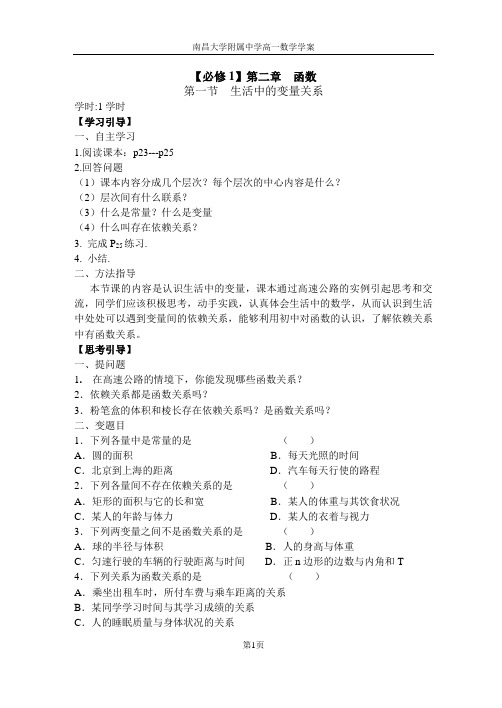
【必修1】第二章函数第一节生活中的变量关系学时:1学时【学习引导】一、自主学习1.阅读课本:p23---p252.回答问题(1)课本内容分成几个层次?每个层次的中心内容是什么?(2)层次间有什么联系?(3)什么是常量?什么是变量(4)什么叫存在依赖关系?3. 完成P25练习.4. 小结.二、方法指导本节课的内容是认识生活中的变量,课本通过高速公路的实例引起思考和交流,同学们应该积极思考,动手实践,认真体会生活中的数学,从而认识到生活中处处可以遇到变量间的依赖关系,能够利用初中对函数的认识,了解依赖关系中有函数关系。
【思考引导】一、提问题1. 在高速公路的情境下,你能发现哪些函数关系?2.依赖关系都是函数关系吗?3.粉笔盒的体积和棱长存在依赖关系吗?是函数关系吗?二、变题目1.下列各量中是常量的是()A.圆的面积B.每天光照的时间C.北京到上海的距离D.汽车每天行使的路程2.下列各量间不存在依赖关系的是()A.矩形的面积与它的长和宽B.某人的体重与其饮食状况C.某人的年龄与体力D.某人的衣着与视力3.下列两变量之间不是函数关系的是()A.球的半径与体积B.人的身高与体重C.匀速行驶的车辆的行驶距离与时间D.正n边形的边数与内角和T 4.下列关系为函数关系的是()A.乘坐出租车时,所付车费与乘车距离的关系B.某同学学习时间与其学习成绩的关系C.人的睡眠质量与身体状况的关系D.树木的高度与土壤的关系5.给出下列情境与关系:(1)某护士从上午8:00到下午2:00每小时量一次病人的体温,结果如下表:(体温单位:C o) Array关系为:病人的体温与时间的关系.(2)班上有45位同学,每人都有一个不同的学号,某次数学测验共有36个不同的分数.关系为:学生的分数与学号的关系.(3)上网查阅资料时,某网页的点击率与时间t的关系.其中属于函数关系的是_______________________.【总结引导】1.具有依赖关系的两个变量,不一定具有函数关系.2.当且仅当对于其中一个变量的每一个值,另一个变量都有_____________,才称这两个变量之间有函数关系.3.如何区分两个变量是依赖关系还是函数关系?【拓展引导】一、课外作业:P25 1二、课外思考:1. 请列举一些与公路有关的函数关系.2. 请思考在其它环境下存在的函数关系.撰稿:黄福萍审稿:宋庆参考答案【思考引导】二,变题目1.C2.D3.B4.A5 . (1)(2)(3)撰稿:黄福萍审稿:宋庆【必修1】第二章函数第二节对函数的进一步认识(1)学时:1学时【学习引导】 一、自主学习 1.阅读P 26—P 27 2.回答问题:(1)课本内容分成几个层次?每个层次的中心内容是什么? (2)层次间有什么联系?(3)函数的定义是什么?定义域是什么?值域又是什么? (4)如何用区间来表示不等式? 3.完成P 28练习 4.小结二、方法指导学习本节内容时,同学们要对照初中所学的函数的概念,结合集合的知识进一步认识函数。
新概念NCE-1 L23教案新部编本
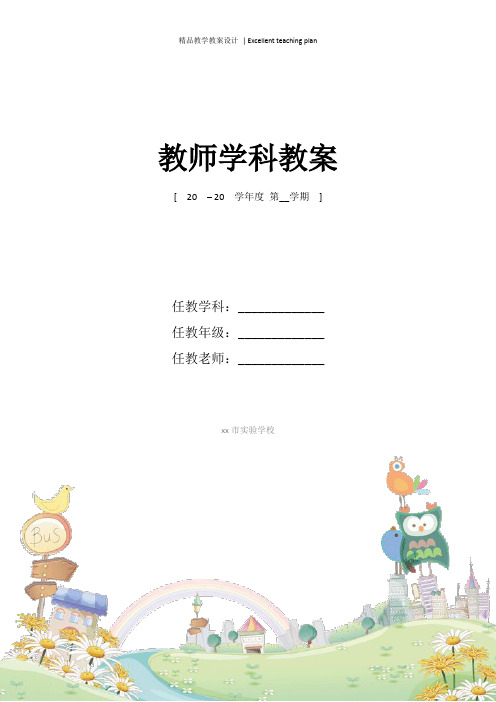
教师学科教案[ 20 – 20 学年度第__学期]任教学科:_____________任教年级:_____________任教老师:_____________xx市实验学校Lesson23 Which glasses?哪几只杯子?New Words and Expressions◆on prep.①在……之上Eg. The book is on the table. 书在桌子上。
Have you any money on you? 你身上有钱吗?He put a ring on her finger. 他给她的手上戴上了戒指。
②在……的时候a.表星期on Monday, on Fridayb.表日期on Sep. 18th, on Oct. 1st , on New Year’s Dayc.特定某日中的一段时间on the morning of last Sunday③向着……, 朝着……play joke on sb. 开某人玩笑hit sb. On the head 击打某人的头look on sb. 望着某人(look on 带有感情色彩,又继续的意思;look at 只是一般的看)④依据……,凭借……live on rice 主食大米act on sb. Advice 按照某人的劝告做a story based on fact 根据事实写成的故事⑤为……; 因……; 从事于……on business 因公on holiday 度假on duty 值班on fire 着火on sale 出售⑥用于“on + the + adj.”结构中,表示态度,情况,行动on the cheap 廉价on the sly 秘密地⑦以……方式hear music on the radio 开收音机听音乐talk on the telephone 在电话里交谈⑧有关短语put on 穿上,戴上and so on 等等on and on 持续不停的on time 准时◆shelf n. 架子,搁板①(柜橱,书架等的)搁板,搁架put up a shelf 搭搁板a shelf full of crockery 摆满了陶器的架子‘a bookshelf 书架②搁板状物,(尤指)悬崖等上突出的岩石,大陆架The continental shelf 大陆架③习语on the shelfa.(of a person)put aside as if no longer useful (指人被闲置,似已无用)A retire person should not be made to feel he’s on the shelf.不应该让退休的人感到自己是个闲人。
1lesson23教案
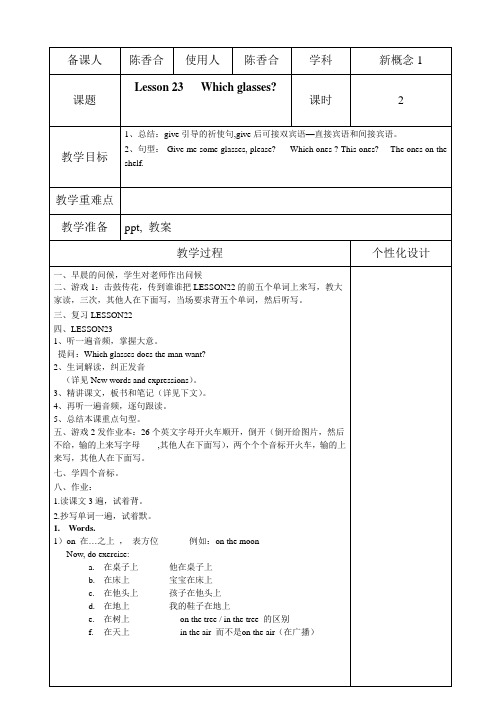
备课人陈香合使用人陈香合学科新概念1课题Lesson 23 Which glasses?课时 2教学目标1、总结:give引导的祈使句,give后可接双宾语—直接宾语和间接宾语。
2、句型:-Give me some glasses, please? - Which ones ? This ones? -The ones on the shelf.教学重难点教学准备ppt, 教案教学过程个性化设计一、早晨的问候,学生对老师作出问候二、游戏1:击鼓传花,传到谁谁把LESSON22的前五个单词上来写,教大家读,三次,其他人在下面写,当场要求背五个单词,然后听写。
三、复习LESSON22四、LESSON231、听一遍音频,掌握大意。
提问:Which glasses does the man want?2、生词解读,纠正发音(详见New words and expressions)。
3、精讲课文,板书和笔记(详见下文)。
4、再听一遍音频,逐句跟读。
5、总结本课重点句型。
五、游戏2发作业本:26个英文字母开火车顺开,倒开(倒开给图片,然后不给,输的上来写字母,其他人在下面写),两个个个音标开火车,输的上来写,其他人在下面写。
七、学四个音标。
八、作业:1.读课文3遍,试着背。
2.抄写单词一遍,试着默。
1. Words.1)on 在…之上,表方位例如:on the moonNow, do exercise:a. 在桌子上他在桌子上b. 在床上宝宝在床上c. 在他头上孩子在他头上d. 在地上我的鞋子在地上e. 在树上 on the tree / in the tree 的区别f. 在天上 in the air 而不是on the air(在广播)【New words and expressions】★on prep. 在……之上on the tree (果实、树叶等)在树上in the tree (人或物)在树上[Grammar]定语:定语:是修饰限定的成份,做定语的词一般是形容词,但也可用介词短语或定语从句做定语。
苏教版数学高二-《新学案》 选修1-1教学案 1.3.1量词

1.3.1量词教学过程一、问题情境在日常生活和学习中,我们经常遇到这样的命题:(1)所有中国公民的合法权利都受到中华人民共和国宪法的保护;(2)对于任意实数x,都有x2≥0;(3)存在有理数x,使x2-2=0.二、数学建构问题1上述命题与以前学过的命题有何不同?问题2能说出上面3句话中的含义吗?解命题(1):只要是“中国公民”,其合法权利都受到中华人民共和国宪法的保护.命题(2):对每一个实数x,必有x2≥0,即没有使x2≥0不成立的实数x存在.命题(3):至少可以找到一个有理数x,使x2-2=0成立.1.全称量词“所有”“任意”“每一个”等表示全体的量词在逻辑中称为全称量词,通常用符号“∀x”表示“对任意x”.2.存在量词“有一个”“有些”“存在一个”等表示部分的量词在逻辑中称为存在量词,通常用符号“∃x”表示“存在x”.3.全称命题与存在性命题(1)含有全称量词的命题称为全称命题,含有存在量词的命题称为存在性命题.(2)全称命题与存在性命题的一般形式:全称命题:∀x∈M,p(x);存在性命题:∃x∈M,p(x).其中M为给定的集合,p(x)是一个关于x的命题.三、数学运用【例1】判断下列命题是全称命题还是存在性命题:(1)有一个实数a,a不能取对数;(2)所有不等式的解集A,都有A⊆R;(3)三角函数都是周期函数;(4)有的向量方向不定;(5)自然数的平方是正数. (见学生用书P9)引导学生说出每一个命题中的量词,再结合全称命题和存在性命题的定义得到答案.解(1)存在性命题;(2)全称命题;(3)全称命题;(4)存在性命题;(5)全称命题.(1) 判断一个语句是全称命题还是存在性命题,应先判断它是否为命题;(2) 判断命题是全称命题还是存在性命题,主要是看命题中是否含有全称量词或存在量词,要注意的是有些全称命题中并不含有全称量词(如“对顶角相等”),这时我们就要根据命题的意义去判断.【例2】(教材第14页例1)判断下列命题的真假:(1)∃x∈R,x2>x;(2)∀x∈R,x2>x;(3)∃x∈Q,x2-8=0;(4)∀x∈R,x2+2>0. (见学生用书P10)师生共同分析,找出判断全称命题和存在性命题真假的一般方法.解(1) 因为当x=2时,x2>x成立,所以“∃x∈R,x2>x”是真命题.(2)因为当x=0时,x2>x不成立,所以“∀x∈R,x2>x”是假命题.(3)因为使x2-8=0成立的数只有x=2与x=-2,但它们都不是有理数,所以“∃x∈Q,x2-8=0”是假命题.(4)因为对于任意实数x,都有x2+2>0成立,所以“∀x∈R,x2+2>0”是真命题.(1) 要判定一个存在性命题为真命题,只要在给定的集合中,找到一个元素x,使命题p(x)为真命题,否则命题为假命题.(2) 要判定一个全称命题为真命题,必须对给定的集合的每一个元素x,p(x)都为真命题;但要判定一个全称命题为假命题,只要在给定的集合内找出一个x0,p(x0)为假命题.【例3】用量词符号“∀”“∃”表达下列命题:(1)实数都能写成小数形式;(2)凸n边形的外角和等于2π;(3)任一个实数乘以-1都等于它的相反数;(4)存在实数x,使得x3>x2;(5)对任意角α,都有sin2α+cos2α=1.先找到命题中的全称量词或存在量词.解(1)∀x∈R,x能写成小数形式;(2)∀x∈{x|x是凸n边形},x的外角和等于2π;(3)∀x∈R,x·(-1)=-x;(4)∃x∈R,x3>x2;(5)∀α∈{角},sin2α+cos2α=1.正确认识存在量词和全称量词的符号表示.四、课堂练习1.判断下列命题是全称命题还是存在性命题:(1)所有能被2整除的整数都是偶数;(2)有的函数是偶函数;(3)圆周上任意一点到圆心的距离都等于圆的半径;(4)三角形有且仅有一个外接圆.解(1) 全称命题;(2)存在性命题;(3)全称命题;(4)全称命题.2.指出下列命题中的量词,并判断命题的真假.(1)任意一个正方形都是矩形;(2)所有的一元二次方程都有实数根;(3)至少存在一个锐角α,使得sinα=.解(1)任意;真命题.(2)所有;假命题.(3)存在;真命题.五、课堂小结1.全称命题和存在性命题的含义.2.判断全称命题和存在性命题真假的方法.。
NCE1 L71 72新概念一教案新部编本

教师学科教案[ 20 – 20 学年度第__学期]任教学科:_____________任教年级:_____________任教老师:_____________xx市实验学校New Concept English ITeaching content: L71 72 By: Miss Mo Teaching aims: Date: Oct.14th ,20121.Ss review the use of the Past Simple tense.2.Ss study more on regular verbs' past forms.Teaching methods:1.Audio lingual approach.2.Pair work and group work.petition and role-play method.Teaching procedures:Step One: Warm up1. Greeting.2. Revision--Ss recite Lesson67 69--Check Homework.3. Free talk:WeatherStep Two: Lead in New Lesson and presentation.L71 1. Learn in new words &expressions--Ask Ss to read this words by themselves.--Then T to teach Ss to read.--At last, read together and then check Ss to read.2. Lead in Lesson- T/S look at the pictures on P141, and try to tell why he is awful.3.Presetation--Ss watch the video th en answer this question, “How did Pauline answer the telephone at nine o’clock?”--T/S study the dialogue between Jane and Pauline together, pay attention to the use of the Past Simple tense, especially regular verbs' past forms there.--Ss read the dialogue aloud once.--T/S try to retell the story in their own words.4. Key patternsComprehension1 T: Is Ron Marston nice? S: No, he isn’t.2 T: What’s he like? S: He’s awful.3 T: What did Ron Marston do yesterday? S: He telephoned Pauline four times.$ T: How many times did he telephone the day before yesterday? S: Three times.5 T: When did Ron Marston telephone the office? S: Yesterday morning andyesterday afternoon.6 t: Who answered the telephone? S: Pauline did.7 T: What time did Pauline arrive home yesterday evening? S: At six o’clock.8 T: Did she answer the phone? S: No, she didn’t.9 T: What time did Ron Marston telephone last night? S: At nine o’clock.10 T: Did he telephone you again? S: NO, he didn’t.Step Three: Lead in New Lesson and presentation.L72 1. Learn in new words &expressions--Ask Ss to read this words by themselves.--Then T to teach Ss to read.--At last, read together and then check Ss to read.2. Lead in Lesson--T/S first compare different times on TODAY, YESTERDAY and THE DAY BEFORE YESTERDAY in the box on P143.--T/S then study picture 1~15 on P143 for regular verbs’past forms, pay attention to the pronunciation of “ed”.--T/S do Exercise A on P144 together.--T/S study the example in Exercise B, Ss do Exercise 1~5 with a partner orally.--T/S check the answers.Step Four :Classroom activity: describing words.--Ss take turns and come up to the blackboard to write a word, other Ss try to explain or demonstrate the meaning in English. Let the teacher guess.Step Five: Homework1.Read English at least 20 minutes, recite L712.Copy and recite L71 724times,then have a dictation.3.Reading&Listening.4.Write composition.。
小学数学教学课件模板

输入标题 输入标题 输入标题
输入标题
01 点击添加标题 02 点击添加标题 03 点击添加标题 25% 04 点击添加标题
45% 35%
43%
01 添加标题
在此录入上述图表的综合 描述说明,在此录入上述 图表的综合描述说明,在 此录入上述图表的综合描 述说明。
教学内容
点击输入文本内容点击 输入文本内容点本内容点击输入 文本内容点击输入文本
点击输入文本内容点击 输入文本内容点击输入 文本内容点击输入文本
点击输入文本内容点击输入文本内容点击输入文本内容点击输入文本内容点击输入文本内容点击输入文本内容 点击输入文本内容点击输入文本内容点击输入文本内容点击输入文本内容点击输入文本内容点击输入文本内容
01. 点击此处替换文本内容,单击添加文字 内容,言简意赅不罗嗦。
03.
点击此处替换文本内容, 单击添加文字内容,言简 意赅不罗嗦。
02. 点击此处替换文本内容,单击 添加文字内容,言简意赅不罗 嗦。
04. 点击此处替换文本内容,单击添加文字 内容,言简意赅不罗嗦。
单击此处添加标题
点击输入文本内容点击输入文本内容点击输入文本
第二章
教学设计
Teaching analysis
教学内容
点击输入文本内容点击输入 文本内容点击输入文本内容
点击输入文本
教学内容
点击输入文本内容点击输入 文本内容点击输入文本内容
点击输入文本
教学内容
点击输入文本内容点击输入 文本内容点击输入文本内容
点击输入文本
6%
二次根式化简的教案
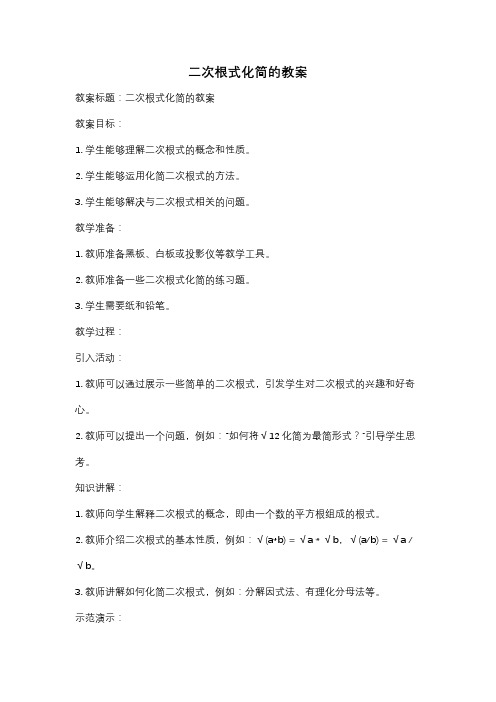
二次根式化简的教案教案标题:二次根式化简的教案教案目标:1. 学生能够理解二次根式的概念和性质。
2. 学生能够运用化简二次根式的方法。
3. 学生能够解决与二次根式相关的问题。
教学准备:1. 教师准备黑板、白板或投影仪等教学工具。
2. 教师准备一些二次根式化简的练习题。
3. 学生需要纸和铅笔。
教学过程:引入活动:1. 教师可以通过展示一些简单的二次根式,引发学生对二次根式的兴趣和好奇心。
2. 教师可以提出一个问题,例如:“如何将√12化简为最简形式?”引导学生思考。
知识讲解:1. 教师向学生解释二次根式的概念,即由一个数的平方根组成的根式。
2. 教师介绍二次根式的基本性质,例如:√(a*b) = √a * √b,√(a/b) = √a / √b。
3. 教师讲解如何化简二次根式,例如:分解因式法、有理化分母法等。
示范演示:1. 教师通过示范演示如何化简一些简单的二次根式,例如:√(16/4),√(27*2)等。
2. 教师在黑板上或投影仪上展示步骤,并解释每一步的原理和方法。
练习活动:1. 学生进行个人或小组练习,化简一些给定的二次根式。
2. 教师巡视并提供必要的指导和帮助。
3. 学生可以互相交流和讨论,共同解决问题。
总结回顾:1. 教师和学生一起回顾本节课所学的内容,强调二次根式化简的重要性和实际应用。
2. 教师可以提供一些综合性的问题,让学生运用所学知识解决。
拓展延伸:1. 对于进一步挑战的学生,教师可以提供更复杂的二次根式化简练习题。
2. 教师可以引导学生思考二次根式的实际应用,例如在几何图形中的应用等。
评估反馈:1. 教师可以布置一些作业,让学生继续巩固和应用所学的知识。
2. 教师可以通过课堂练习、讨论和学生的提问来评估学生的理解情况。
教案结束。
高一数学 平面向量教案26 苏教版 教案
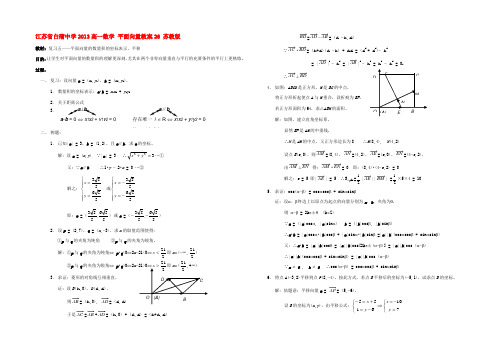
江苏省白蒲中学2013高一数学 平面向量教案26 苏教版教材:复习五——平面向量的数量积的坐标表示、平移目的:让学生对平面向量的数量积的理解更深刻,尤其在两个非零向量垂直与平行的充要条件的平行上更熟练。
过程:一、 复习:设向量a = (x 1,y 1),b = (x 2,y 2),1. 数量积的坐标表示:a •b = x 1x 2 + y 1y 2 2. 关于距离公式3.二、 例题:1. 已知|a | = 3,b = (1,2),且a ∥b ,求a 的坐标。
解:设a = (x ,y ) ∵|a | = 3 ∴322=+y x …①又:∵a ∥b ∴1•y - 2•x = 0 …②解之:⎪⎪⎩⎪⎪⎨⎧==556553y x 或⎪⎪⎩⎪⎪⎨⎧-=-=556553y x即:a = (556,553) 或a = (556,553--) 2. 设p = (2,7),q = (x ,-3),求x 的取值范围使得:①p 与q 的夹角为钝角 ②p 与q 的夹角为锐角。
解:①p 与q 的夹角为钝角⇔ p •q <0⇔2x -21<0⇔221<x 即x ∈(-∞,221) ②p 与q 的夹角为锐角⇔ p •q >0⇔2x -21213. 求证:菱形的对角线互相垂直。
证:设B (b 1,0),D (d 1,d 2),则AB = (b 1,0), AD = (d 1,d 2)于是AC =AB +AD = (b 1,0) + (d 1,d 2) = (b 1+d 1,d 2)BD =AD -AB = (d 1 -b 1,d 2)∵AC •BD = (b 1+d 1)(d 1 -b 1) + d 2d 2 = (d 12+ d 22)- b 12= |AD |2- b 12= |AB |2- b 12= b 12- b 12= 01∴AC ⊥BD4. 如图:ABCD 是正方形,M 是BC 的中点,将正方形折起使点A 与M 重合,设折痕为EF ,若正方形面积为64,求△AEM 的面积。
教案NO.1二次根式
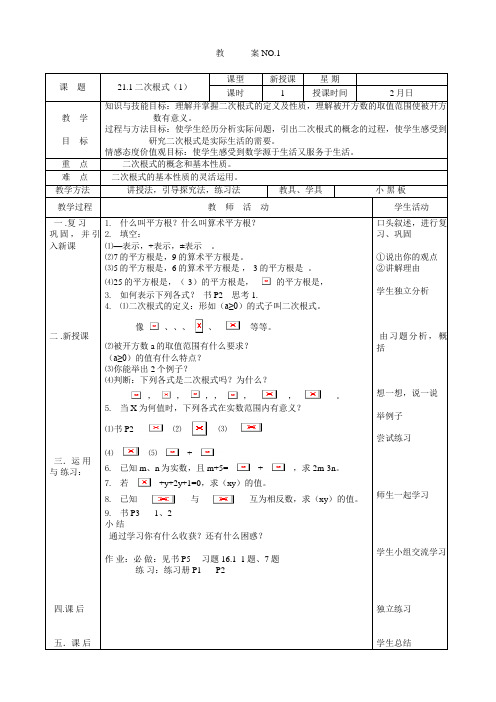
课 题
21.1二次根式(1)
课型
新授课
星期
课时
1
授课时间
2月日
教 学
目 标
知识与技能目标:理解并掌握二次根式的定义及性质,理解被开方数的取值范围使被开方数有意义。
过程与方法目标:使学生经历分析实际问题,引出二次根式的概念的过程,使学生感受到研究二次根式是实际生活的需要。
情感态度价值观目标:使学生感受到数学源于生活又服务于生活。
重 点
二次根式的概念和基本性质。
难 点
二次根式的基本性质的灵活运用。
教学方法
讲授法,引导探究法,练习法
教具、学具
小黑板
教学过程
教 师 活 动
学生活动
一.复习
巩固,并引入新课
二.新授课
三.运用
与练习:
四.课后
五.课后
1.什么叫平方根?什么叫算术平±表示。
⑵7的平方根是,9的算术平方根是。
小结
通过学习你有什么收获?还有什么困惑?
作业:必做:见书P5 ---习题16.1 1题、7题
练习:练习册P1-----P2
口头叙述,进行复习、巩固
①说出你的观点
②讲解理由
学生独立分析
由习题分析,概括
想一想,说一说
举例子
尝试练习
师生一起学习
学生小组交流学习
独立练习
学生总结
板书
设计
21.1二次根式(1)
一.二次根式:二.练习与运用
①定义:
②被开方数a的取值范围有什么要求?
(a≥0)的值有什么特点?
③你能举出2个例子?
④判断:下列各式是二次根式吗?为什么?
, , ,, , , 。
NCE-Book1(上)新概念基础教案新部编本

教师学科教案[ 20 – 20 学年度第__学期]任教学科:_____________任教年级:_____________任教老师:_____________xx市实验学校武汉博奥学校WUHAN BOAO SCHOOL1-上新概念英语___________’s 教案上课时间:_____________________上课教室:_____________________英语教研部Date: Number:Lesson 1-4Teaching aims:1. Learn and master the words in this lesson.2. Review the Attribute Clause.Teaching contents:1. Difficult points: Is this your ...? This is not ...2. Important points: useful expressions: Excuse me! Pardon? Here is ...Pronouns: your, myTeaching aids / methodsCards stationeries and clothes Pair workTeaching ProcedureStep 1 Greeting1. Hello! Nice to meet you!2. Sing a song about friend. Then give a brief self-introductions and ask the students' for information.Step 2 Lead-inBackground knowledge1. Introduce the school things by asking the students what they can see in the classroom.2. Play a game. The rule is to ask the whole class to close their eyes and get the school things from them. And ask them to say what they have lost.3. The teacher take out the things and ask "Is this your ...?" and return them to the students one by one till they answer "Yes, it is."Step 3 Presentation1. Tell a story concerning a girl's trip to somewhere to introduce the key expressions such as in the first lesson.2. Explain the text.3. Role play.Step 4 Practice1.Each student gets one piece of paper and draws the school things on and writes the name on the bottom of the picture.2.Collect the pictures and practice the dialogue as follows:Excuse me!Yes?Is this your ...?Pardon?...3.Translate the sentences givenStep 5 Grammar and Key structuresSentence structure: Is this your ...?My ... and my ...Here is your ...HomeworkFeedback:Date: Number:Lesson 5-8Teaching aims:1. Learn and master the words and key expressions in this lesson.2. Review the sentence pattern "is this".Teaching contents:1. Difficult points: Are you ..? Yes, I am. / No, I'm not.2. Important points: French, German, Japanese, Korean, ChineseThis is ...He/She is...Teaching aids / methodsCD Cards Pair workTeaching ProcedureStep 1 Revision1. Words dictation2. Sentences translation3. Homework checkingStep 2 Lead-inBackground knowledgeTake out the national flags of different countries to learn the nationalities.Step 3 Presentation1. Get to know the ways to introduce somebody to others.2. Get to know some friends' names and write them on the left of the Bb and stick the national flags to the right of the Bb.3. Listen to the dialogue and match the names with the nationalities.4. Ask individuals to introduce each of the friends with the sentence pattern such as "This is ... He / She is ..."5. Learn the dialogue.The above five procedures are for Lesson 5-6. For the latter two, see the following items: 1) The teacher has the cards in hands, with the front side facing the audience. Ask them "Areyou ... ?" "Yes, I am. / No, I'm not."2) Each one gets a flag and another one guess by asking "Are you ... ?" "Yes, I am. / No, I'mnot."Step 4 Practice1. Make sentences2. Role play with the help of cards of flags.3. Learn words about jobs and practise by acting and guessing. And try to say your dream by telling others "I am... "Step 5 Grammar and Key structuresSentence structures:Are you ..? Yes, I am. / No, I'm not.What nationality are you? I am ...What's your job? I am ...HomeworkFeedback:Date: Number:Lesson 9-12Teaching aims:1. Learn and master the words and key expressions in this lesson.2. Review the sentence pattern: Are you..? Yes, I am. / No, I'm not.What nationality are you? I am... What's your job? I am...Teaching contents:1. Difficult points: Whose is this/that...? It's ...2. Important points: the way to greet friends.Whose is this/that...? It's ...Teaching aids / methodsCD TV Cards Pair workTeaching ProcedureStep 1 Revision1.Words dictation2.Sentences translation and dialogues reciting3.Homework checkingStep 2 Lead-inBackground knowledgeTell a story about animals to introduce the way to greet others.Step 3 Presentation1. Take out some cards about animals and schoolchildren to ask them to greet each other.2. Learn the dialogue.3. Role play.4. Show the pictures of diverse people to lead in the patterns "Look at... He/ She is..."Ss try to describe to pictures all by themselves.The above four procedures are for Lesson 9-10. For the latter two, see the following items:1. Collect the school things from the students. And ask "Is this your ...?” "Whose is this ...?" and help them to answer.2. Hand out the pictures of stationeries and clothes they drew last time and encourage them to ask "Is this your ...? ""Whose is this ...?"3. Learn the dialogues.Step 4 Practice1. Make sentences2. Role playStep 5 Grammar and Key structuresSentence structures:Whose is this / that...? It's ...HomeworkFeedback:Date: Number:Lesson 13-16Teaching aims:1. Learn and master the words and key expressions in this lesson.2. Review the way to greet friends and the sentence pattern:Is this your ...?Whose is this / that ...? It's ...Teaching contents:1. Difficult points: Are you...? Yes, we are. / No, we are not.2. Important points: What colour's your ...? It's ...What colour are your...? They're...Teaching aids / methodsCD TV Cards Pair workTeaching ProcedureStep 1 Revision1.Words dictation2.Sentences translation and dialogues reciting3.Homework checkingStep 2 Lead-inBackground knowledgeTell a story about some girls who are pretty and like to purchase.Step 3 Presentation1. Review different colours and the sentence pattern "What colour is your ...?" ask various things the children know and encourage them tell the colours.2. Listen to the dialogue and answer the questions below:1) What colour is Anna's hat?2) Whose dress is green?3) Is Anna's hat new?3. Learn the dialogue and explain the key points.4. Show the pictures the students have learned and those they have not. Require them to see the pictures for 30 seconds and ask one of the students to guess the colours of the things he or she has seen.5. Look at the pictures in Lesson 14, and try to make dialogues. Work in groups.6. Do the written exercises.The above procedures are for Lesson 13-14. For the latter two, see the following items:1) Tell the students some knowledge about the procedures of customs clearance.2) Translation from Chinese to English and then change them to the plural forms.3) Learn the new words in Lesson 13.4) Explain the key language points.5) Role play.Step 4 Practice1.Try to translate the sentences and see which group is faster.2.New words.3.Do the written exercises.Step 5 Grammar and Key structuresSentence structures: Are you...? Yes, we are. / No, we are not.What colour's your ...? It's ...What colour are your...? They're ...HomeworkFeedback:Date: Number:Lesson 17-20Teaching aims:1. Learn and master the words and key expressions in this lesson.2. Review the sentence pattern: Are you..? Yes, I am. / No, I'm not.What nationality are you? I am... What's your job? I am...Teaching contents:1. Difficult points: Whose is this / that ...? It's ...2. Important points: the way to greet friends.Whose is this/that ...? It's ...Teaching aids / methodsCD TV Cards Pair workTeaching ProcedureStep 1 Revision1. Words dictation2. Sentences translation and dialogues reciting3. Homework checkingStep 2 Lead-inBackground knowledgeTell a story about animals to introduce the way to greet others.Step 3 Presentation1. Take out some cards about animals and schoolchildren to ask them to greet each other.2. Learn the dialogue.3.Role play.4.Show the pictures of diverse people to lead in the patterns "Look at... He/ She is..."Ss try to describe to pictures all by themselves.The above four procedures are for Lesson 9-10. For the latter two, see the following items:1. Collect the school things from the students. And ask "Is this your ...? ""Whose is this ...?" and help them to answer.2. Hand out the pictures of stationeries and clothes they drew last time and encourage them to ask "Is this your ...? ""Whose is this ...?"3. Learn the dialogues.Step 4 Practice1. Make sentences2. Role playStep 5 Grammar and Key structuresSentence structures:Whose is this / that...? It's ...HomeworkFeedback:Date: Number:Lesson 21-24Teaching aims:1. Learn and master the words and key expressions in this lesson.2. Review the sentence pattern: Whose is this / that...? It's ...the way to greet friends.Teaching contents:1. Difficult points: me/him/her/us/them2. Important points: Give me / him / her / us / them a ...Which one?Give me / him / her /us / them some ...Which ones?Teaching aids / methodsCD TV Cards Pair workTeaching ProcedureStep 1 Revision1. Words dictation2. Sentences translation and dialogues reciting3. Homework checkingStep 2 Lead-inAsk the student to list the names of the things in the classroom including their stationeries.Step 3 Presentation1. Collect the school things from each student by asking "give me a ... please."2. Make a dialogue with one student.3. Give me a book please.Which book?This one?No, not that one. The red one.4. Ask each student to get their staff back by asking "give me a ... please." to practice the above dialogue.5. Conclude the rules of the pronouns and practice "Give me/him/her/us/them a ...."6. Learn the new words and expressions in Lesson 22. Try to make dialogues and guess what's in the teacher's hand.7. Do the written exercises in Lesson 22.The above four procedures are for Lesson 21-22. For the latter two, see the following items: Review the pronouns and ask the Ss to try to translate the sentences from Chinese to English to review the dialogue they have just learned and the related plural forms as follows:1) Give me some glasses please.Which glasses?These glasses?No, not those. The ones on the shelf.2) Give me / him / her / us / them some ...Which ones?Step 4 Practice1. Learn the new words in Lesson 24 and try to practice the dialogues in pairs.2. Do the written exercises in Lesson 24.Step 5 Grammar and Key structuresGive me/him/her/us/them a ...Which one?Give me / him / her / us / them some ...Which ones?HomeworkFeedback:Date: Number:Lesson 25-28Teaching aims:1. Learn and master the words and key expressions in this lesson.2. Review the pronouns: me / him / her / us / them3. Review the sentence pattern: Give me / him / her / us / them a ...Which one?Give me / him / her / us / them some ...Which ones?Teaching contents:1. Difficult points: "There be" sentence patterns both in single and plural forms2. Important points: There is a refrigerator in the kitchen.There are some magazines on the television.Prepositions: in, on, nearTeaching aids / methodsCD TV Cards Pair workTeaching ProcedureStep 1 Revision1. Words dictation2. Sentences translation and dialogues reciting3. Homework checkingStep 2 Lead-inAsk the student to list the names of the things in the classroom including their stationeries.Step 3 Presentation1. The teacher gives an example by describing the things in the classroom such as "There is a blackboard in the classroom."2. The Ss imitate the teacher and say something using the pattern of "There is ... "3. Summarize the rules and structure of "There be" sentence pattern.4. Handout some paper to each of the students and ask them to draw a picture according to the teachers' words. And check their masterpiece by asking them to describe their pictures with "There be ..."5. Learn the new words in Lesson 25. And try to illustrate the things in the picture.6. Learn the passage in Lesson 25 and explain the key language points.7. Practice the dialogue in Lesson 26 and do the written exercises in Lesson 26.The above procedures are for Lesson 25-26. For the latter two, see the following items:1) Try to translate the sentences from C to E and try to change them to their plural forms.2) Learn Lesson 27 and ask the students to say the next sentence with the books closed.Step 4 Practice4.Learn the new words in Lesson 28.5.Practise the dialogues in Lesson 28.3. Do the written exercises in Lesson 28.Step 5 Grammar and Key structuresThere is a refrigerator in the kitchen.There are some magazines on the television.Prepositions: in, on, nearHomeworkFeedback:Date: Number:Lesson 29-32Teaching aims:1. Learn and master the words and key expressions in this lesson.2. Review "There be" sentence patterns both in single and plural forms There is a refrigerator in the kitchen.There are some magazines on the television.Prepositions: in, on, nearTeaching contents:1. Difficult points: Imperative sentencePresent continuous forms2. Important points: What must I do?Come in. Shut the door. Open the window and air the room.Where’s Sally?What's he / she / it doing?He's / She's ...Teaching aids / methodsCD TV Cards Pair workTeaching ProcedureStep 1 Revision1. Words dictation2. Sentences translation and dialogues reciting3. Homework checkingStep 2 Lead-inAsk the students to do as the teacher ordered.Stand up. / Sit down. / Put up you hands. / Put down your hands. / Bend your knees.Step 3 Presentation1. Conclude the rules of imperative sentence2. Learn new words and learn the dialogue in Lesson 29.3. Underline the imperative sentences, and then role play. One is MRS JONES and the other AMY. See who is the best in acting.4. Learn new words in Lesson 30 and practise them from C to E.5. Do the written exercises.The above procedures are for Lesson 29-30. For the latter two, see the following items:1) Review the imperative sentence and ask some of the students to do as instructed to introduce the present continuous tense.2) Sum up the structure of the present continuous tense.3) Learn the new words and expressions. Then look at the picture and tell us what's in the picture.There is / are ...4) Listen to the dialogue for one time and answer the questions, then check the answer.5) Role play.6) Summarize the rules of how to change a verb to a present participle.Step 4 Practice1. Learn the new words in Lesson 32.2. Hand out the cards and ask the students to make sentences.6.Guess W hat’s in the teacher's hand.4. Written exercises.Step 5 Grammar and Key structuresImperative sentence: What must I do?Come in. Shut the door. Open the window and air the room. Present continuous forms: What must I do?Come in. Shut the door. Open the window and air the room.Where’s Sally?What's he / she / it doing?He's / She's...HomeworkFeedback:Date: Number:Lesson 33-35Teaching aims:1. Learn and master the words and key expressions in this lesson.2. Review imperative sentence and present continuous formsTeaching contents:1. Difficult points: Present continuous forms2. Important points: Present continuous formsThere is / are ...Prepositions: in, on, over, on, under, between, beside Teaching aids / methodsCD TV Cards Pair workTeaching ProcedureStep 1 Revision1. Words dictation2. Sentences translation and dialogues reciting3. Homework checkingStep 2 Lead-inAsk the students to do as the teacher ordered.Step 3 Presentation1. Learn the new words and give some related expansion. Ask the students to make some sentences.2. Look at the picture and try to describe something or close the books and answer the teachers questions like "What's in the sky?" "What's on the bridge?" "What are they doing?"3. Explain the key language points in Lesson4. Retell the story.5. Ask two students to do as instructed. Ask the others "What are they doing" "They are ...". Then review the rules of how to add -ing to a verb.6. Do written exercises in Lesson 34. Boys and girls work in groups to act and answer two after another two.Step 4 Practice1.Learn the new words in Lesson 35.2.Listen to the passage for one time and answer the questions put forward.3.Explain the key language points in the passage.Step 5 Grammar and Key structures1. Present continuous forms2. There is / are ...3. Prepositions: in, on, over, on, under, between, besideHomeworkFeedback:Date: Number:Lesson 36~38Teaching aims:1. Re view the changing forms of V-ing.2. Review the prepositions of locality, and let students know how to ask according to the place. Master the Key structures “Where is / are ...?”3. Learn and master the new words in the lesson.4. Learn and master the simple future tense “be going to ...”, and how to ask with question words.Teaching contents:1. Difficult points: the simple future tense2. Important points: how to ask with question wordsTeaching aids / methodsCD Cards Pair workTeaching ProcedureStep 1 Revision1. Checking the homework2. DictationStep 2 Lead-inShow some pictures about Lesson37, lead students answe r “What is the man doing?” The teacher says: “The man is making a bookcase.” Then, ask, “What is the man doing?” Lead students to answer, “He is making a bookcase”.Step 3 Presentation1. Let the students listen to the tape then answer the question below.What is Susan's favourite colour?2. V ocabulary teaching1) make v.做,制作,制造She makes her own clothes.This kind of mobile phone is made in Beijing.铺(床)Please make you bed before breakfast.规定,制定They have made a study plan for this term.2) homework [u] n. 作业,家庭作业home(家庭)+ work(工作)= homework(家庭作业)house(家)+ work(工作)= housework(家务活)paper (文件)+ work(工作)= paperwork(文案工作)3) listen 听(强调听的动作,不显示结果)listen to 听见……hear 听见(强调听的结果)3. Text learning1) What are you doing ?这是一个现在进行时的特殊疑问句,由特殊疑问词what帮助构成。
新概念第一册教案完整版
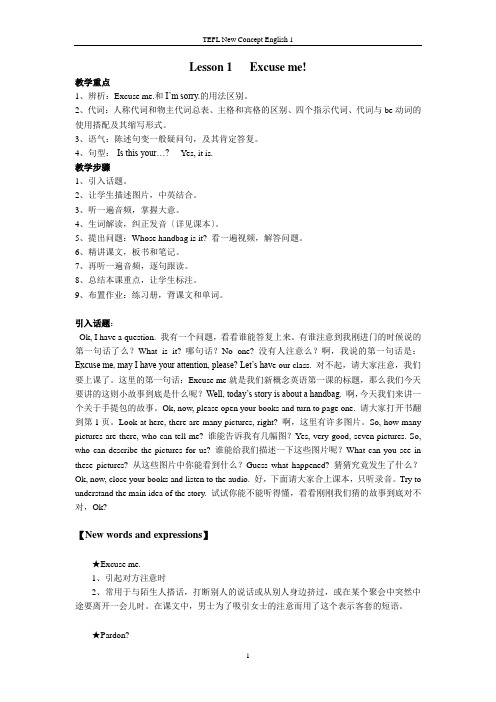
Lesson 1 Excuse me!教学重点1、辨析:Excuse me.和I’m sorry.的用法区别。
2、代词:人称代词和物主代词总表、主格和宾格的区别、四个指示代词、代词与be动词的使用搭配及其缩写形式。
3、语气:陈述句变一般疑问句,及其肯定答复。
4、句型:-Is this your…? -Yes, it is.教学步骤1、引入话题。
2、让学生描述图片,中英结合。
3、听一遍音频,掌握大意。
4、生词解读,纠正发音〔详见课本〕。
5、提出问题:Whose handbag is it? 看一遍视频,解答问题。
6、精讲课文,板书和笔记。
7、再听一遍音频,逐句跟读。
8、总结本课重点,让学生标注。
9、布置作业:练习册,背课文和单词。
引入话题:Ok, I have a question. 我有一个问题,看看谁能答复上来。
有谁注意到我刚进门的时候说的第一句话了么?What is it? 哪句话?No one? 没有人注意么?啊,我说的第一句话是:Excuse me, may I have your attention, please? Let’s hav e our class. 对不起,请大家注意,我们要上课了。
这里的第一句话:Excuse me就是我们新概念英语第一课的标题,那么我们今天要讲的这则小故事到底是什么呢?Well, today’s story is about a handbag. 啊,今天我们来讲一个关于手提包的故事。
Ok, now, please open your books and turn to page one. 请大家打开书翻到第1页。
Look at here, there are many pictures, right? 啊,这里有许多图片。
So, how many pictures are there, who can tell me? 谁能告诉我有几幅图?Yes, very good, seven pictures. So, who can describe the pictures for us? 谁能给我们描述一下这些图片呢?What can you see in these pictures? 从这些图片中你能看到什么?Guess what happened? 猜猜究竟发生了什么?Ok, now, close your books and listen to the audio. 好,下面请大家合上课本,只听录音。
二氧化碳和一氧化碳导学案新部编版.doc
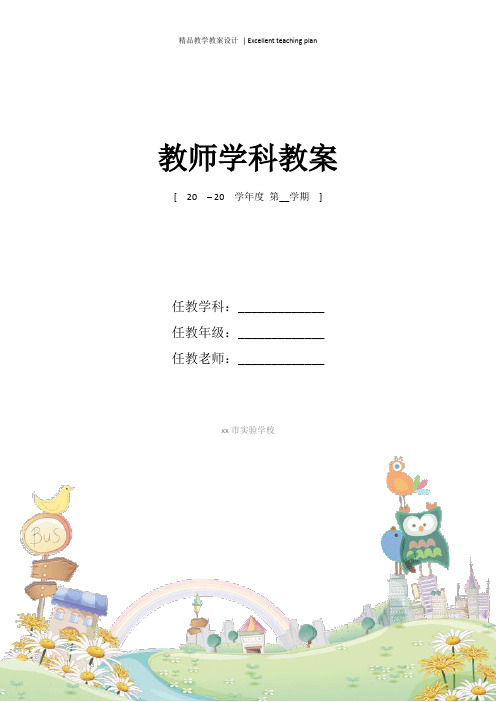
6.下图是验证二氧化碳性质的实验,请回答下列问题。
①A处能观察到___________,说明了二氧化碳能与____反应,化学方程式为______________________
②B处能观察到___________,说明二氧化碳能与_____反应,化学方程式为
③C处能观察到_______________________,
说明7.北方的农村,许多人家里都设有地窖用来贮存蔬菜。由于植物的致使里面含有大量的气体,因此,人们在进入地窖之前,往往会做一个“实验”就是把燃着的蜡烛先放入地窖里,如果看到,证明里面聚有大量的气体,不宜进入;当看到,证明里面的气体较少,可以进去。
(四)二氧化碳对生活和环境的影响
1、二氧化碳的含量高影响人体健康:回答116页讨论
(1)、二氧化碳本身没有毒性、但二氧化碳不能供给呼吸。当空气中的二氧化碳超过正常含量时,会对人体健康产生影向,甚至是人因缺氧而窒息死亡。
(2)、看图6-16总结二氧化碳用途:①灭火②化工原料、化肥③干冰
2、温室效应:自然界中二氧化碳的含量高会导致温室效应。阅读课本117页填下列空:
3.鉴别氧气和二氧化碳两瓶无色气体可选用的方法或试剂是()
①石蕊试液②澄清石灰水③燃着的木条④水
A.①②③④B.只有①②③C.只有①②D.只有②③
4.利用大棚栽培农作物,科技人员常向大棚内施放适量CO2,这是因为()
A.CO2会使大棚内温度急剧升高B.CO2可使害虫窒息死亡
C.CO2能灭火D.CO2可促进植物进行光合作用
想一想:一氧化碳与二氧化碳的分子结构有什么不同?它们的性质相同吗?
进入久未开启的菜窖前,必须先做灯火试验(即先将燃着的蜡烛缓缓放入菜窖中,若蜡烛不熄灭,则是安全的;反之,则不安全)原因是什么?
新课标人教版实验高一数学必修1A教案(全知识点+典型例题讲解)
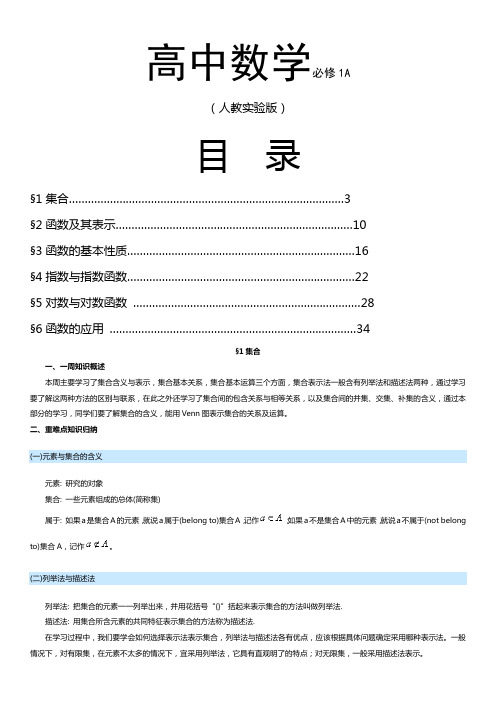
高中数学必修1A(人教实验版)目录§1集合 (3)§2函数及其表示 (10)§3函数的基本性质 (16)§4指数与指数函数 (22)§5对数与对数函数 (28)§6函数的应用 (34)§1集合一、一周知识概述本周主要学习了集合含义与表示,集合基本关系,集合基本运算三个方面,集合表示法一般含有列举法和描述法两种,通过学习要了解这两种方法的区别与联系,在此之外还学习了集合间的包含关系与相等关系,以及集合间的并集、交集、补集的含义,通过本部分的学习,同学们要了解集合的含义,能用Venn图表示集合的关系及运算。
二、重难点知识归纳(一)元素与集合的含义元素: 研究的对象集合: 一些元素组成的总体(简称集)属于: 如果a是集合A的元素,就说a属于(belong to)集合A,记作;如果a不是集合A中的元素,就说a不属于(not belong to)集合A,记作。
(二)列举法与描述法列举法: 把集合的元素一一列举出来,并用花括号“{}”括起来表示集合的方法叫做列举法.描述法: 用集合所含元素的共同特征表示集合的方法称为描述法.在学习过程中,我们要学会如何选择表示法表示集合,列举法与描述法各有优点,应该根据具体问题确定采用哪种表示法。
一般情况下,对有限集,在元素不太多的情况下,宜采用列举法,它具有直观明了的特点;对无限集,一般采用描述法表示。
(三)子集、真子集、空集子集: 一般地,对于两个集合A,B,如果集合A中任意一个元素都是集合B中的元素,我们就说这两个集合有包含关系,称集合A为集合B的子集(subset),记作(或),读做“A包含于B”(或“B包含A”).真子集: 如果集合,但存在元素,且,我们称集合A是集合B的真子集(proper subset),记作(或).空集: 不含任何元素的集合叫做空集(empty set),记作,并规定:空集是任何集合的子集Venn图: 在数学中,我们经常用平面上封闭曲线的内部代表集合,这种图称为Venn图.学习这几个概念时,应注意以下几点:①若集合A是集合B的真子集,那么集合A必是集合B的子集,反之则不一定。
2022-2023学年高二数学人教A版(2019)选择性必修第一册教案:2.2.1直线的点斜式方程
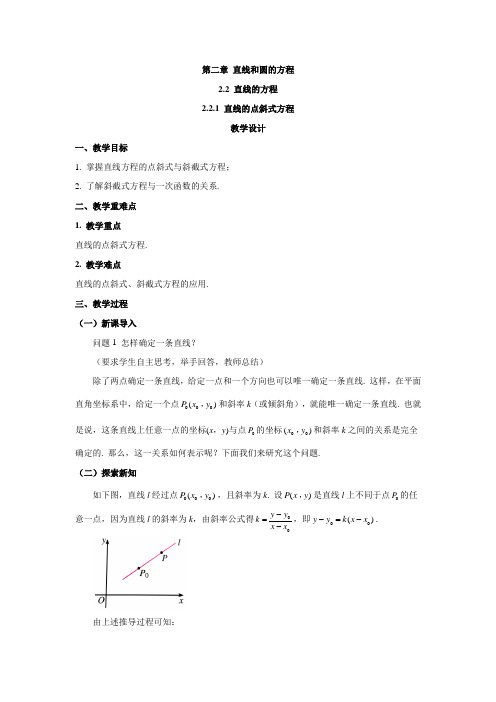
第二章 直线和圆的方程2.2 直线的方程 2.2.1 直线的点斜式方程教学设计一、教学目标1. 掌握直线方程的点斜式与斜截式方程;2. 了解斜截式方程与一次函数的关系. 二、教学重难点 1. 教学重点 直线的点斜式方程. 2. 教学难点直线的点斜式、斜截式方程的应用. 三、教学过程 (一)新课导入问题1 怎样确定一条直线?(要求学生自主思考,举手回答,教师总结)除了两点确定一条直线,给定一点和一个方向也可以唯一确定一条直线. 这样,在平面直角坐标系中,给定一个点000()P x y ,和斜率k (或倾斜角),就能唯一确定一条直线. 也就是说,这条直线上任意一点的坐标(x ,y )与点0P 的坐标00()x y ,和斜率k 之间的关系是完全确定的. 那么,这一关系如何表示呢?下面我们来研究这个问题. (二)探索新知如下图,直线l 经过点000()P x y ,,且斜率为k . 设()P x y ,是直线l 上不同于点0P 的任意一点,因为直线l 的斜率为k ,由斜率公式得0y y k x x -=-,即00()y y k x x -=-.由上述推导过程可知:(1)直线l 上每一个点的坐标(x ,y )都满足关系式00()y y k x x -=-; (2)反过来,坐标满足关系式00()y y k x x -=-的每一个点都在直线l 上.验证(2):事实上,若点111()P x y ,的横纵坐标11x y ,满足关系式00()y y k x x -=-,则1010()y y k x x -=-.当10x x =时,10y y =,这时点1P 与0P 重合,显然有点1P 在直线l 上; 当10x x ≠时,有1010y y k x x -=-,这表明过点1P ,0P 的直线1l 的斜率为k . 因为直线l ,1l 的斜率都为k ,且都过点0P ,所以它们重合. 所以,点1P 在直线l 上.由(1)(2)可得:坐标满足关系式00()y y k x x -=-的点一定在直线l 上;直线l 上任意一点的坐标一定满足关系式00()y y k x x -=-. 我们把方程00()y y k x x -=-称为过点000()P x y ,,斜率为k 的直线l 的方程.定义:方程00()y y k x x -=-由直线上一个定点00()x y ,及该直线的斜率k 确定,我们把它叫做直线的点斜式方程,简称点斜式.问题2 (1)当直线l 的倾斜角为0°时,直线l 的方程是什么?为什么? (2)当直线l 的倾斜角为90°时,直线l 的方程如何表示?为什么? (要求学生以小组为单位讨论,每组选出代表回答,教师引导、总结)如下图,当直线l 的倾斜角为0°时,tan00︒=,即0k =,这时直线l 与x 轴平行或重合,直线l 的方程是00y y -=,即0y y =.如下图,当直线l 的倾斜角为90°时,由于tan90︒无意义,直线没有斜率,这时直线l 与y 轴平行或重合,它的方程不能用点斜式表示. 又因为这时直线l 上每一点的横坐标都等于0x ,所以它的方程是00x x -=,即0x x =.例1 直线l 经过点0(23)P -,,且倾斜角45α=︒,求直线l 的点斜式方程,并画出直线l .解:直线l 经过点0(23)P -,,斜率tan451k =︒=,代入点斜式方程得32y x -=+. 画图时,只需再找出直线l 上的另一点111()P x y ,,例如,取11x =-,则14y =,得点1P 的坐标为(14)-,,过0P ,1P 两点的直线即为所求,如下图所示.如果斜率为k 的直线l 过点0(0)P b ,,这时0P 是直线l 与y 轴的交点,代入直线的点斜式方程,得(0)y b k x -=-,即y kx b =+.我们把直线l 与y 轴的交点(0)b ,的纵坐标b 叫做直线l 在y 轴上的截距. 这样,方程y kx b =+由直线的斜率k 与它在y 轴上的截距b 确定,我们把方程y kx b =+叫做直线的斜截式方程,简称斜截式. 其中,k 和b 均有明显的几何意义:k 是直线的斜率,b 是直线在y 轴上的截距.例2 已知直线111222::l y k x b l y k x b =+=+,,试讨论:(1)12l l 的条件是什么?(2)12l l ⊥的条件是什么?解:(1)若12l l ,则12k k =,此时12l l ,与y 轴的交点不同,即12b b ≠;反之,若12k k =,且12b b ≠,则12l l .(2)若12l l ⊥,则121k k =-;反之,若121k k =-,则12l l ⊥.由例2得到,对于直线111222::l y k x b l y k x b =+=+,, 1212l l k k ⇔=,且12b b ≠;12121l l k k ⇔⊥=-.(三)课堂练习1.已知直线的方程为21y x +=--,则( ) A.该直线过点()1,2-,斜率为1- B.该直线过点()1,2-,斜率为1 C.该直线过点()1,2--,斜率为1- D.该直线过点()1,2--,斜率为1答案:C解析:直线的方程可化为点斜式(2)[(1)]y x --=---,故直线过点(1,2)--,斜率为1-.故选C.2.经过点(3,2)-,倾斜角为60°的直线方程是( )A .23)y x +=-B .23)y x -=-C .23)y x -=+D .23)y x +=- 答案:C解析:tan 60k =°23)y x -=+.故选C. 3.已知直线l 过点()3,0-,且与直线12y x +=垂直,则直线l 的方程为( ) A.1(3)2y x =--B.1(3)2y x =-+C.1(3)2y x =-D.1(3)2y x =+答案:B解析:因为直线12y x +=的斜率为2,所以直线l 的斜率为12-.又直线l 过点()3,0-,故所求直线的方程为()132y x =-+,故选B. 4.已知直线l 的倾斜角是直线1y x =+的倾斜角的2倍,且过点()5,6P ,则直线l 的方程为________________.答案:5x = 解析:直线1y x =+的倾斜角是45°,且直线l 的倾斜角是直线1y x =+的倾斜角的2倍,∴直线l 的倾斜角是90°.又直线l 过点()5,6P ,∴直线l 的方程为5x =.5.已知点()33A ,和直线35:42l y x =-. (1)求过点A 且与直线l 平行的直线的点斜式方程; (2)求过点A 且与直线l 垂直的直线的点斜式方程. 答案:(1)因为直线l 的方程为3542y x =-,所以该直线的斜率34k =,所以过点()3,3A 且与直线l 平行的直线的点斜式方程为33(3)4y x -=-.(2)易知与直线l 垂直的直线的斜率为43-,所以过点()3,3A 且与直线l 垂直的直线的点斜式方程为43(3)3y x -=--.(四)小结作业 小结:1. 直线的点斜式方程;2. 直线的斜截式方程; 作业: 四、板书设计2.2.1 直线的点斜式方程1. 直线的点斜式方程;2. 直线的斜截式方程;3. 两条直线的位置关系.。
2019年高中化学创新设计人教版必修1(鄂)全套学案课件第一章第一节第1课时

第一节 化学实验基本方法 第1课时 化学实验安全 过滤与蒸发[知 识 梳 理]知识点一 化学实验安全化学实验需要注意哪些安全事项,你了解这些安全标志吗?完成下列知识点你就会了解:1.遵守实验室规则走进实验室,首先要认真阅读并牢记实验室的安全规则。
2.了解安全措施常用危险化学品的标志及其分类3.掌握正确的操作方法(1)物质加热:在横线上填上所选用的仪器。
(2)药品取用:在横线上填上所选用的仪器。
4.实验后药品的处理方法(1)实验用剩的试剂一般不放回原试剂瓶,以防污染试剂。
(2)实验后的废液用废液缸收集,实验后集中处理。
提醒:取用任何化学试剂时,均不能用手直接去拿,即使是无毒的药品(如镁条、铝片、食盐等)也不能用手直接取用。
知识点二混合物的分离和提纯混合物的分离是依据混合物中各组分性质的差异进行的。
常见的混合物分离方法有过滤、蒸发、蒸馏和萃取等。
1.过滤和蒸发(1)过滤分离固体和液体。
写出下图仪器的名称。
(2)蒸发将可溶性固体溶质从溶剂中分离出来。
写出下图仪器的名称。
(3)粗盐的提纯①不溶性杂质的除去。
②粗盐中可溶性杂质的除去。
(4)SO2-4的检验[效果自测]1.判断正误,正确的打“√”,错误的打“×”。
(1)若浓硫酸不慎沾在皮肤上,马上用3%的NaOH冲洗()(2)试管、蒸发皿、燃烧匙可直接加热,烧杯、圆底烧瓶等不可直接加热()(3)过滤时,为了加快过滤速率,可用玻璃棒在过滤器内搅拌()(4)用蒸发皿蒸发溶液时,边加热边用玻璃棒搅拌,直到液体全部蒸干()【参考答案】(1)×(2)√(3)×(4)×2.过滤的仪器需要________、________、玻璃棒、滤纸及带铁圈的铁架台。
【参考答案】漏斗烧杯3.下列事故或药品的处理正确的是()A.一般用药匙取用粉末状或块状药品B.当出现CO中毒时,应立即将中毒者抬到室外新鲜空气处C.制取并收集氧气结束后,应立即停止加热D.将含硫酸的废液倒入水槽,用水冲入下水道【试题解析】块状药品一般用镊子夹取,A错误;收集O2结束时,先拿出水中导管,再停止加热,C错误;H2SO4废液不能冲入下水道,D错误。
- 1、下载文档前请自行甄别文档内容的完整性,平台不提供额外的编辑、内容补充、找答案等附加服务。
- 2、"仅部分预览"的文档,不可在线预览部分如存在完整性等问题,可反馈申请退款(可完整预览的文档不适用该条件!)。
- 3、如文档侵犯您的权益,请联系客服反馈,我们会尽快为您处理(人工客服工作时间:9:00-18:30)。
If you like this ,you can add our q group. Two five two two seven three four five six.
Key words
1on prep. 介词后面一定要跟动名词或者是名词
On about in of between
Between…A…and…B…. 在A和B之间
情态动词后面要跟动词原形can may must
had better have to不得不必须
on the tree in the tree
Come on 加油拜托go on 继续hold on 别挂电话稍等move on=go on 继续
Go on doing something go on to do something(动词不定式表示未发生)
做的事情没有改变继续做的事情已经改变了
put on 穿上take off 脱下
On sale 出售This style is very popular. It is on sale.
and so on 等等(列举的时候)
2 desk table timetable
3 newspaper-----news+paper new
news north北east东west西south南
4 cigarette n.香烟smoke Do you smoke?
No smoking No parking 1 2 No fishing No swimming
Run---swim—sit AEIOU 元音字母
对于用a an的问题取决于音标而不是字母an honest student 音素5 Mrs.夫人已婚女士的称呼
Miss 未婚女士的称呼miss 1错过2 想念Catch up with 赶上追上
清清浊浊清辅音后面会发音/t/ 浊辅音后面会发出/d/
而t d 后面发音为/id/ want need
Ms未知称呼人是否已婚
6 middle
Middle school中学primary school high school university
Mid-Autumn Festival Spring Festival 春节(农历的新年)
元旦(阳历的新年)Happy New Year
Moon cake
介词in on at with的区别
in
in 2013 in spring in the morning in the afternoon in the evening in May in winter
at noon at night
Do you know the girl in white?
in 用在年份季节月份上午下午晚上in+颜色(表示穿.......颜色的衣服)
on 一般用在具体的某一天或者某一天(具体)的早上下午晚上或者具体的一个节日星期on+天气+早上、下午、晚上
on a cold morning in the morning
On May 1st, 2013on Children’s Day on Sunday morning
on a cold afternoon on Sunday On New Year’s day
i n the tree VS on the tree 的区别
on the tree 指的是树本身的东西例如树上结的水果Eg. There are many apples on the tree.
in the tree 指的是非树木本身的东西例如树上的小鸟Eg. There are many birds in the tree. There are some worms in the tree.
at 一般用在时间的(几点几分)
at five ten at five sharp(表示时间整五点整)at noon 在中午
to past half half an hour quarter = fifteen minutes
1 小时+分钟
2 分钟+小时to past
hour minute second 1 第二2 秒second hand1二手货2 秒针hour hand minute hand hand 1 手 2 指针
with 和......一起classmate deskmate
1 They will have a meeting _ Friday __ 4:30.
2 I’m going to lunch now. Can I speak to you __ the afternoon?
3 We visited the old man in Sunday afternoon (改错)
4 My brother joined the army(参军) ______
A 1989 March
B in March 1989
C March 1989
D 1989 in March
只说月份或者只说年份或者月份加年份我们都会用In
但是如果和日有关也就是年月日或者月+日我们会用on
5 I like to go shopping __ my friends.(和)。
